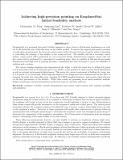Achieving high-precision pointing on ExoplanetSat: Initial feasibility analysis
Author(s)
Pong, Christopher Masaru; Lim, Sungyung; Smith, Matthew William; Villasenor, Jesus Noel Samonte; Seager, Sara; Miller, David W; ... Show more Show less
DownloadPong-2010-Achieving high-precision pointing on ExoplanetSat Initial feasibility analysis.pdf (4.225Mb)
PUBLISHER_POLICY
Publisher Policy
Article is made available in accordance with the publisher's policy and may be subject to US copyright law. Please refer to the publisher's site for terms of use.
Terms of use
Metadata
Show full item recordAbstract
ExoplanetSat is a proposed three-unit CubeSat designed to detect down to Earth-sized exoplanets in an orbit out to the habitable zone of Sun-like stars via the transit method. To achieve the required photometric precision to make these measurements, the target star must remain within the same fraction of a pixel, which is equivalent to controlling the pointing of the satellite to the arcsecond level. The satellite will use a two-stage control system: coarse control will be performed by a set of reaction wheels, desaturated by magnetic torque coils, and fine control will be performed by a piezoelectric translation stage. Since no satellite of this size has previously demonstrated this high level of pointing precision, a simulation has been developed to prove the feasibility of realizing such a system. The current baseline simulation has demonstrated the ability to hold the target star to within 0.05 pixels or 1.8 arcseconds (with an 85 mm lens and 15 μm pixels), in the presence of large reaction wheel disturbances as well as external environmental disturbances. This meets the current requirement of holding the target star to 0.14 pixels or 5.0 arcseconds. Other high-risk aspects of the design have been analyzed such as the effect of changing the guide star centroiding error, changing the CMOS sampling frequency, and reaction wheel selection on the slew performance of the satellite. While these results are promising as an initial feasibility analysis, further model improvements and hardware-in-the-loop tests are currently underway.
Date issued
2010-07Department
Massachusetts Institute of Technology. Department of Aeronautics and Astronautics; Massachusetts Institute of Technology. Department of Earth, Atmospheric, and Planetary Sciences; MIT Kavli Institute for Astrophysics and Space ResearchJournal
Proceedings of SPIE--the International Society for Optical Engineering
Publisher
SPIE
Citation
Christopher M. Pong, Sungyung Lim, Matthew W. Smith, David W. Miller, Jesus S. Villaseñor and Sara Seager, "Achieving high-precision pointing on ExoplanetSat: initial feasibility analysis", Proc. SPIE 7731, 77311V (2010); doi:10.1117/12.857992 © 2010 COPYRIGHT SPIE
Version: Final published version
ISSN
0277-786X